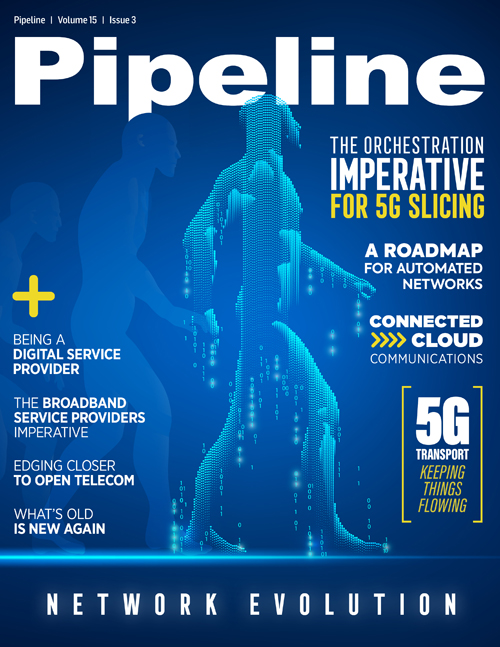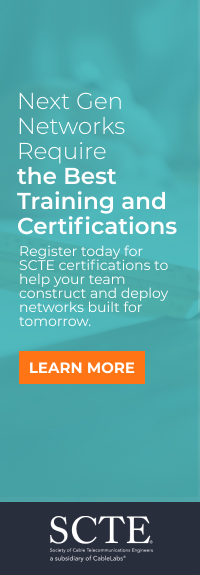By: Mark Cummings, Ph.D., Vinay Devadatta, Christos Kolias
Talk about 5G tends to center on the upsidesâthe new horizons, potential, and use cases that this next-generation network will make possible. While full of promise, that dialogue skirts the
cold reality that 5G deployment will be very expensive. And that expense can only be justified if 5G fully meets its promise. Key to realizing that promise is lowering the capital
burdens CSPs must shoulder. This can best be accomplished by network slicing, which is sharing resources while improving products that allow for the construction of innovative end-to-end
services from atomic units of resource that may transit multiple CSP domainsâŠ
» read this article
By: Stan Hubbard
Throughout the past year, MEF has noted the growing recognition that service providers must move quickly to address changing customer requirements and adapt to intensifying competitive threats
in the era of digital transformation. Executives from MEF member service providers have emphasized that it is imperative that they transform to deliver more dynamic, cloud-like services over
automated and interconnected networks. Top experts from service and technology providers based in more than 35 countries will be assembling at the MEF18 networking event (29 October â 2 November)
with the goal of accelerating progress on this frontâŠ
» read this article
By: Divya Wakankar
In todayâs digital era, businesses are exploring ways to use cloud capabilities to enable mobility, flexibility, and less expensive alternatives to traditional telecommunications, both for
their internal communications as well as connecting with customers, partners and suppliers around the world. As with other areas that have benefited from the cloud, the move is designed to drive
efficiencies, reduce costs and tap into new geographic markets and customer opportunities. In addition, cloud capabilities are a growth catalyst for digital service providers, enabling them to
create a global footprint nearly overnightâŠ
» read this article
By: Mike Vannest
The questions for Communications Service Providers (CSPs) and Data Center Operators is: âwhat are their enterprise customers going to want next?â And, itâs a crucial question to ask, even if
they themselves donât know the answer yet. At a high level, we know enterprise customers generally want operational efficiencies, lower costs, and greater agility to consume, deploy,
performance-tune, and manage IT resources.What if you could have it all? What ifâas a major enterprise company or as a âma and paâ grocery storeâyou could log into one single portal and supply your
company with everything it needed from an IT perspective? What if you could get all of your cloud services through this portalâregardless of provider? What if your network could be supplied to you
on-demand, like a utility? What if you could track, slice, dice, and chargeback all of your IT services in a reliable manner? What if all your IT resources could be correlated and monitored as you
manage for performance? For example, do you have enough compute or are you lacking in network capacity? What if your solution was one click of on-demand, real-time services away? What if you
could grow, shrink, or change your network on-demand through the same portal that you manage, compare, and contrast your public, private, and hybrid cloud services? Do you have to make sure that
your utility provider has proper circuit breakers in place on its way from your provider? Do you have to have a full-time staff of electricians to make sure that your electricity gets from the
water dam to your facility? What if the combination of SDN, SD-WAN, NFVs, SaaS providers, Cloud providers, containerization, AI (Artificial Intelligence) and machine learningâaggregated into a
single pane of glass viewâcould create an ecosystem from which you could manage all of your IT needs and resources? What if that same portal insured your security and governance models, and what if
your users could largely help themselves to what theyâre entitled to do? What if you unleashed the power of your employeesâ creativity by granting them controlled freedom to use technology to make
your company better? What if your employees could self-manage costs and be rewarded for keeping your costs down? What if you knew exactly what the cost of a new office facility was at any moment in
time for all things IT? What does an enterprise need? Answering the question completely is impossible, because no one knows for sureâŠ
» read this article
By: Raj Singh
Broadband providersâespecially those with legacy copper networks and cable networksâare overwhelmed by the pace at which revenue is dissipating. Over the top (OTT) service offerings have hit
full force, attacking every fundamental service that exists except for the âpipeâ to the consumerâs premises. Simply put, voice, video, long distance, international, conferencing services, video
sharing, and more, all of which have traditionally been the domain of the service provider, are no longer safeâŠ
» read this article
By: Prakash Siva
The telecom industry is undergoing a significant transition as service providers and infrastructure vendors are turning to open source and multi-access edge computing (MEC) solutions to meet
the demands of 5Gâand to reduce costs and accelerate service innovation. Open RAN solutions are gaining traction with service providers that are driving disruption in their networks.
5G in the Driverâs Seat The fourth Industrial Revolution provides a roadmap for the evolution of technologyâmoving from connected hardware in the 2G/3G era to connected people with LTE/4G,
to connected everything with the advent of 5GâŠ
» read this article
By: Robin Mersh
By as soon as 2019, 5G will be here, according to Forbes. As more than just the next generation of mobile broadband, the technology is expected to completely transform all aspects of daily
lifeâfrom connected cars to remote surgery, the possibilities for new and innovative services seem endless. To realize this potential and move 5G from concept to reality, a significant investment
is required from operators and equipment manufacturersâand not just in mobile networks. An integral part of 5Gâs success is in providing access to services, regardless of location or device, which
means fixed networks must be fully integrated into mobile networksâŠ
» read this article
By: Tom Brown
The Data Center Exodus From Manhattan Over the course of the last 11 years, there has been a data center exodus from Manhattan for a variety of reasons. Many events took place over this time
period to make data center tenants nervous about locating their data centers in the heart of New York City. The financial crisis of 2007 caused many companies to cut back drastically on information
technology expenditures. Then, one of the tenants at 111 8th Avenue, a large data center located in Manhattan, purchased the building, inspiring fear that the new owners would drive the other data
center tenants out, drastically reducing the amount of available data center colocation space in ManhattanâŠ
» read this article
By: Scott St. John - Pipeline
What is a network? When you think about it, a network can be just about anything. Or perhaps better defined, a network is a group or groups of any interchangeable things. Networks can be
comprised of people, equipment, highways, wires, computers, television programming, or even sewer systems. That's quite a broad range. To further complicate matters, how those groups and
things are connected is also significant; as the connectivity between the parts of the network is integral to how the network is able to functionâŠ
» read this article
By: Scott St. John - Pipeline
This month, Mobile World Congress Americas provided a brief flurry of news from the City of Angels. Together, Ericsson, Intel, AT&T and T-Mobile demonstrated the first public 5G NR
over-the-air data call, and Sprint debuted its newest Magic Box Generation 3 all wireless small-cell plug-and-play unit. A new worldwide relationship between Sprint and Ericsson will result in a
dedicated IoT environment to better handle skyrocketing device data flow and generate immediate intelligence. And AT&T and Aira have expanded their collaboration to serve members of the blind
and low-vision communities at over 5,000 locations across the US with Airaâs wearables or via smartphonesâŠ
» read this article

















